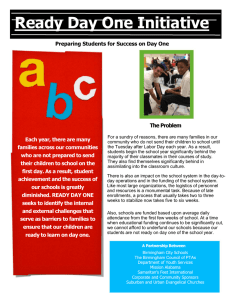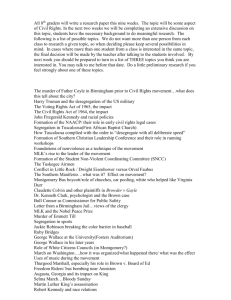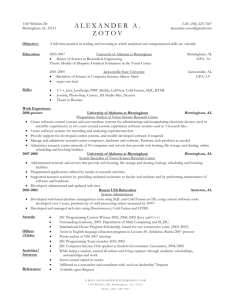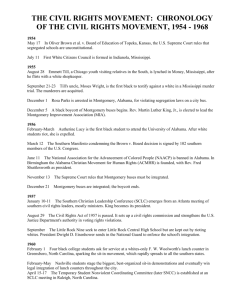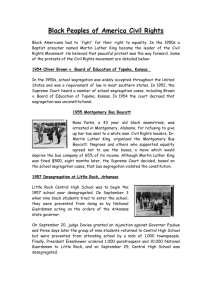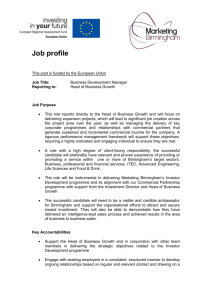Colorful Arts Society SCAVENGER HUNT
advertisement
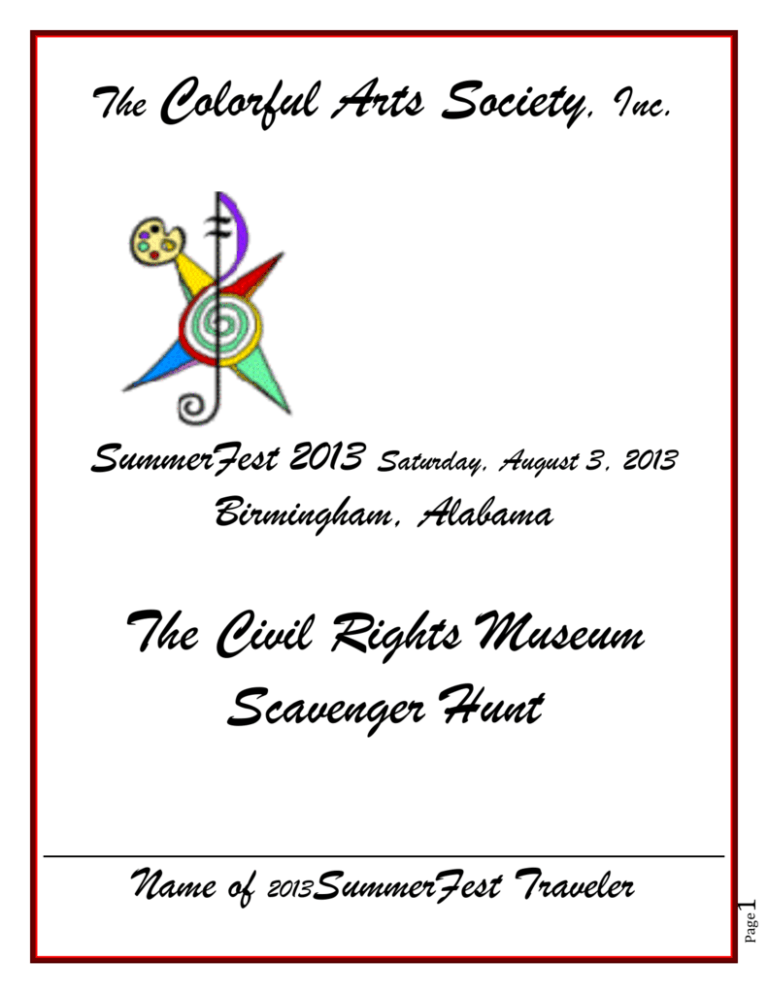
The Colorful Arts Society, Inc. SummerFest 2013 Saturday, August 3, 2013 Birmingham, Alabama Page Name of 2013SummerFest Traveler 1 The Civil Rights Museum Scavenger Hunt Dear 2013 Colorful Arts Society SummerFest Traveler! Your journey from the historic city of Atlanta, Georgia to the historic city of Birmingham, Alabama promises to be memorable and a true walk through a tumultuous period of time in these United States of America! This well-orchestrated journey depicts the fact that art, music, drama, and oration were and are truly gifts of change-agentry! Even more so… it was the known and unknown artists, musicians, dramatists, orators, financiers and architects of the Civil Rights movement who transformed the hearts of people of all races, creeds and levels of economics such that a “new” generation of thinking, caring and artistic people could rise-up and bring forth an improved quality of life and life choices. This 2013 SummerFest journey bespeaks our Nation’s Common Core national educational Standards in the realm of the “arts”. Our 21st century students must be able to analyze how and why individuals, events and ideas develop and interact over the course of time. In other words, as progressive American citizens we must be able to describe the importance of energized, responsive people, within the context of events and developments. Dr. King often said, “Everybody can be great… because anybody can serve.” Today’s journey will focus on the period of time between 1950-1975 ss5H8 wherein one’s change-agentry gifts were impactful. Page Sincerely, Dr. Rebecca Dashiell-Mitchell, Colorful Arts Society Board Member, Scholarship Committee Chair [404-218.4160] rdashiellmitchell@yahoo.com 2 As you review and move through the various galleries/exhibits/halls of the Birmingham Civil Rights Museum, just fill-in the blank spaces of this Scavenger Hunt! What rich discussions we should all experience during and after our return to Atlanta, the City Too Busy to Hate! 2013 The Colorful Arts Society, Inc. Greater Metro Atlanta P.O. Box 142863 Fayetteville, GA 30214 Board of Directors Dr. Mona M. MacDonald, President Emerita Mrs. Audrey Toney, President Mr. Fredrick Wallace, Vice-President Ms. Laura Brown, Board Member Ms. Angelia Blackwell, Legal Advisor Ms. Carrietta Belle Butts, Treasurer Mr. Larry Burney, Financial Secretary Mr. Archie Hale, Board Member Mr. Donald Sims, Parliamentarian Mr. Arnold Martin, Community Board of Advisors Dr. Marty Pinkston, Recording Secretary Dr. Rebecca Dashiell-Mitchell, Board Member Ms. Onie Lawson, Board Member Dr. Lakeacha Jett, Corresponding Secretary Vacant, Resident Artist Page Welcome… 2013 SummerFest Traveler! 3 2013 Program Committee Members: Frederick Wallace [Chairperson], Ernestine Brown, Gladys Crump, Carrie Dumas, *Claudia Lewis [Special Events Chairperson], Dr. Marty Pinkston, and Michelle Thornton! Reverend Fred L. Shuttlesworth Questions for Discussion -What was the Reverend Fred Shuttlesworth trying to achieve through his activism? -What are some specific examples of Shuttlesworth's commitment to nonviolent action? How would you have responded in his situation? -What does a commitment to nonviolence require? Rev. Fred L. Shuttlesworth was a civil rights leader from Birmingham, Alabama. Shuttlesworth grew up in a rural, black community and was educated at Selma University and Alabama State Teachers College. He became a Baptist minister and served a church in Selma and later in Birmingham. In 1956, he founded the Alabama Christian Movement for Human Rights (ACMHR) and the following year, along with Rev. Dr. Martin Luther King Jr. and Rev. Ralph Abernathy, organized the Southern Christian Leadership Conference (SCLC). He also helped the Congress of Racial Equality (CORE) organize the Freedom Rides, two interracial bus rides through the South that tested the enforcement of recent Supreme Court rulings. A fearless advocate of racial equality, King called Shuttlesworth "one of the nation's most courageous freedom fighters." Shuttlesworth was often subjected to violence as a consequence of his actions. In 1956, after the Montgomery bus boycott and Supreme Court ruling, Shuttlesworth announced that unless the Birmingham city buses were desegregated, black residents would begin sitting in the front of the buses on December 26. On Christmas night, a bomb blast destroyed his home. Incredibly, Shuttlesworth emerged only slightly injured, and the demonstration took place as planned. Over the years, he was assaulted by police dogs and knocked unconscious by a high-pressure fire hose. In 1957, three years after the Supreme Court ruled in Brown v. Board of Education that segregated schools were unconstitutional; Shuttlesworth and his wife escorted their children to Phillips High School in Birmingham in an attempt to integrate the all-white public school. A white mob that gathered beat him with brass knuckles and chains, and stabbed his wife. Although he was nearly killed by the mob, Shuttlesworth did not strike back at his attackers, but instead moved through the hostile crowd as best he could. At a mass meeting that evening, Shuttlesworth used the incident to teach a lesson on nonviolence. He asked everyone who was angry about the attack to stand. Everyone stood. Then he asked everyone who had been beaten that day to remain standing. Everyone sat down. He said, "That's strange, I was beat up and I'm not angry." He went on to say, "You got to suffer for what you believe in… It's going to better the lives of people around you and behind you. That's what we are fighting for…That's what the Movement is all about." The Teachers’ Domain Civil Rights Special Collection is produced by WGBH Boston, in partnership with the Birmingham Civil Rights Institute and Washington University in St. Louis. Funding was provided by the Institute for Museum and Library Services and the Open Society Institute. www.teachersdomain.org Page In 1981, he organized the Shuttlesworth Housing Foundation, which provides grants to help poor families in Cincinnati become homeowners. In March 2006, at 84, Rev. Shuttlesworth retired from his pastorate of Greater New Light Missionary Baptist Church in Cincinnati, Ohio. 4 Rev. Shuttlesworth was responsible for inviting Rev. Dr. Martin Luther King, Jr. to begin civil rights work in Birmingham, Alabama that led to King’s “Letter from a Birmingham Jail”. The letter was a response to eight white Birmingham clergymen who denounced King as an outsider whose work in the city was “untimely”. Over the years, Rev. Shuttlesworth was also instrumental in organizing bus boycotts, student sit-ins, the Freedom Rides, and boycotts of segregated businesses. He also initiated lawsuits attacking segregation ordinances. In March 1965, he helped organize the march from Selma to Montgomery to protest voting discrimination in Alabama. SCAVENGER HUNT PLEASE NOTE: DO NOT USE THE WALLS IN THE GALLERIES AS A HARD SURFACE FOR WRITING. YOU MAY BRING OUR OWN BOOK, CLIPBOARD, & OR PENCIL TO USE. THANKS IN ADVANCE FOR HONORING THIS REQUEST AND HELPING TO MAINTAIN THE BIRMINGHAM CIVIL RIGHTS INSTITUTE. Barriers Gallery 1. ________________ was a two-sport professional athlete. 2. _________________ transportation was segregated in Birmingham. 3. The signs of _____________ served as constant reminders of the strict separation of races in the South. 4. In the 1930s, black workers led efforts to form independent ______________. 5. Beginning in the 1880s ______________ of African-Americans found work in the iron ore mines and steel mills of Birmingham. 6. In 1950, the average class size was ________ compared to 35 in white schools. 7. That same year, Alabama spent __________ on each white child, but only $60 per black pupil. 8. The “____________ Circuit” was home to many outstanding jazz musicians; it was also a stop on the black entertainment of Southern cities. 9. John T. “Fess” Whatley shaped a generation of _________ musicians who played in major U.S. bands of the 1930s, ‘40s, and ‘50s. 10. Religious institutions were also the center of the community’s ____________, civic, and even economic development. Page 12. Although they’re painful to view, these everyday objects tell a story of how _______________ images were distorted by whites. 5 11. Church leaders were also ____________ leaders. 13. Birmingham is a city of neighborhoods that developed around major iron and _________________ mills and mines. 14. Adequate housing, _____________ care, and protection under the law were part of life for most white citizens but sorely lacking for blacks. 15. Differences in income between Birmingham’s black and white citizens reflected limited _______________ opportunities. 16. The courts offered __________ protection, allowing white juries to punish blacks, while setting white prisoners free. 17. In 1954, The United States Supreme Court ruled segregated schools ____________. 18. Smith and ___________ Funeral Homes grew to include insurance companies, construction firms, a business school, and Gaston Motel. 19. Caricature of African-Americans appeared on postcards, _________ tobacco tins, and toys. Confrontation Gallery 20. In 1954, following the stunning legal victory of Brown vs. Board of Education, the fight against _______________ gained strength. 21. From the late 1940s until the mid 1960s, nearly 50 unsolved racially directed bombings led to the unofficial name, _______________. Movement Gallery 22. Ku Klux Klan increased intimidation with ____________ through Birmingham’s neighborhoods. 23. In the late 1955, a quiet courageous woman named Rosa Parks refused to give her seat to a white man on a crowded __________________ city bus. Page 25. In early 1960, black college students were active in the civil rights movement with ________________ at local “whites only” lunch counters. 6 24. In Montgomery, segregated city buses were a constant reminder of _________. 26. Many Nashville students attended ______________ workshops for months before the first sit-ins. 27. Legally banned, segregation on the interstate buses persisted in the _____________. 28. The trouble for Freedom Riders began outside___________, Alabama, where one bus was forced to stop and a firebomb was thrown inside. 29. In the summer of 1961, the Student Nonviolent Coordination Committee (SNCC) joined forces with _____________ residents, SCLC, and NAACP to fight segregation there. 30. While blacks made up a large portion of the Southern population, they were deprived of democracy’s most basic right: ____________. 31. Alabama banned the National Association for the Advancement of Colored People (NAACP) from _____________ in the state on June 1, 1956. 32. Combining the legal tactics of the NAACP with the nonviolence confrontation of the voting movement, the (Alabama Christian Movement for Human Rights) ACMHR attacked segregation in __________________. 33. A carefully planned campaign of ___________ and sit-ins began in early 1963. 34. Reverend Dr. Martin Luther King, Jr. was ______________ on Good Friday, April 12. 35. On May 2, over ____________ marched in waves from Sixteenth Street Baptist Church. 36. Over the next 5 days, police arrested ________________s of young people, overflowing the city and county jails. 37. Unable to turn back the masses, policemen used high power fire hoses and attack __________ to control demonstrators. Page 39. The bombing and the death of ______________ children sparked outrage and sorrow around the world, making the violent September day a major turning point in the civil rights movement. 7 38. September 5, 1963-Floyd and ___________ Armstrong are the first students to enroll in Birmingham’s desegregated schools. 40. In 1965, the fight for ______________ rights moved to Selma. 41. The murder of Jimmie Lee Jackson, a young Black activist, prompted a 54-mile ________________ march to Montgomery. 42. The attack against _______________ participating in peaceful civil rights demonstrations in May 1963 took place in Kelly Ingram Park, which is visible from this window. Park Gallery 43. In 1969, _________________ Black leaders sent a telegram to the city’s white elected officials and civic leaders citing __________________ specific injustices that they wanted addressed. 44. __________________________ served five consecutive terms as mayor of Birmingham. (Hint: He was Birmingham, AL’s first African American mayor.) BCRI Milestones Gallery 45. The Birmingham Civil Rights Institute is a “_________________ ________________”, which views the lessons of the past as crucial to understanding our heritage and defining our future. 46. More than _________________ people visited the Institute during its first two weeks. Human Rights Gallery 47. May 22, 2002-__________________ is convicted of first degree murder and sentenced to life imprisonment (for his role in the Sixteenth Street Baptist Church). 48. Public Safety Commissioner ____________ “___________” _____________ relied on 2 armored personnel carriers to intimidate and scare demonstrators during the civil rights era. Page 50. Mothers of the Plaza: Because of a law forbidding groups of people from standing still, the mothers walk around and around the plaza. They wear white _________________ imprinted with the name of their children and carry family _________________. 8 49. Music has always been a part of the ___________________ for change. 51. What impacted you the most on your tour today of the Birmingham Civil Rights Institute? What lessons from the Movement can you take to help make the world a better place? __________________________________________________________________________ __________________________________________________________________________ __________________________________________________________________________ ____________________________________________________________________________ 50 Years Ago… The March on Washington, D.C. Page 9 Where were you? What did your parents and grandparents say and do? Rev. Dr. Martin Luther King Jr.: A CHRONOLOGY Martin Luther King, Jr. is born is Atlanta, Georgia on January 15. He was originally christened Michael Luther King, Jr., but in 1933 his father changed both their names. 1942 King enters Booker T. Washington High School in Atlanta, Georgia. 1944 King enters Morehouse College in Atlanta, Georgia. 1947 King is licensed to preach and becomes assistant to his father, who is pastor of the Ebenezer Baptist Church in Atlanta, Georgia. 1948 February 25, King is ordained to the Baptist ministry. In June he graduates from Morehouse College with a degree in sociology and in September he enters Crozer Theological Seminary in Chester, Pennsylvania. 1951 King graduates from Crozier Theological Seminary and then attends Boston University. 1953 King marries Coretta Scott of Marion, Alabama. 1954 King becomes pastor of Dexter Avenue Baptist Church in Montgomery, AL. On May 17th, the U.S Supreme Court rules that segregation in public schools is unconstitutional (Brown vs. Board of Education of Topeka, Kansas). 1955 King receives a Ph.D in Systematic Theology from Boston University on June 5th. In December, Rosa Parks is arrested for refusing to give up her seat on a segregated bus. Dr. King is called to lead the bus boycott in Montgomery, Alabama as president of the newly established, Montgomery Improvement Association. 1956 King’s house is bombed. Supreme Court rules segregation on buses is illegal in Montgomery. The Montgomery Bus Boycott ends in December after 382 days. 1959 King visits India. The King family leaves Montgomery, Alabama and goes back to Atlanta, Georgia. 1961-62 King’s efforts to desegregate Albany, Georgia were successfully halted by the city’s police chief, Laurie Pritchett. 1963 While jailed in Birmingham, Alabama, King responds to letter written by eight white Alabama clergymen with his “Letter from a Birmingham Jail.” On August 28th, Dr. King gives his “I Have a Dream” speech. 1964 Dr. King receives the Nobel Peace Prize in Oslo, Norway. 1965 In March, Dr. King leads protest march from Selma to Montgomery, Alabama. 1968 Dr. King is assassinated by James Earl Ray in Memphis, Tennessee on April 4th. Page Compiled by the Birmingham Civil Rights Institute, Archives Department December 1994, Revised April 1998, May 2008 10 1929 Civil Rights Timeline 1865 Thirteenth Amendment: Slavery is abolished in the United States. 1865 June 19: American slaves in Galveston, Texas receive notification of their freedom by U.S. General Gordon Granger – 2.5 years after they had been freed by the Emancipation Proclamation. Since then, celebrations of this news are known as “Juneteenth.” 1865 The Ku Klux Klan is formed in Pulaski, Tennessee. 1870 Fifteenth Amendment: Black men are given the right to vote. 1870 Hiram Revels becomes the first Black Senator in the United States of America. 1896 Plessy v. Ferguson – This landmark U.S. Supreme Court case upheld the separate but equal doctrine and was Nineteenth Amendment – Black women, along with all women, are granted the right to vote. 1938 U.S. Supreme Court rules that states must provide equal educational facilities for blacks. The plaintiff, Lloyd Gaines of Missouri, mysteriously disappears after the court’s decision. 1943 Congress on Racial Equality (CORE) stages its first successful sit-in at a Chicago restaurant. 1954 May 17: Brown v. Board of Education of Topeka, Kansas-U.S Supreme Court rules that segregated schools are “inherently unequal” and orders that schools be integrated with “all deliberate speed”. Washington, DC and Baltimore, MD begin desegregating schools. 1955 August 28: Emmett Louis Till, a 14-year-old Chicago boy, is murdered in Money, MS after allegedly wolfwhistling at a white woman. 1955 December 1: Rosa Parks is arrested for refusing to give up her seat on a bus in Montgomery, AL. A well planned boycott of the city buses continued for over a year and resulted in the desegregation of city buses and the hiring of black bus drivers. 1956 November 13: Montgomery Bus Boycott ends after a federal court rules that racial bus segregation in Montgomery, AL is unconstitutional. 1956 Sovereignty Commission is formed by state legislature and approved by the Governor of Mississippi. Its purpose was to investigate all individuals and groups involved in civil rights meetings, demonstrations and actions. The information compiled was turned over to local law enforcement, some of whom were Klansmen. The Commission was finally disbanded in 1977. 1956 December 25: Rev. Fred Shuttlesworth’s house is bombed. This is one of numerous assassination attempts on his life. The next day he went ahead with planned direct action to desegregate buses in Birmingham,AL following the Supreme Court ruling regarding bus desegregation in Montgomery,AL. This resulted in one of several arrests that led to cases in the Supreme Court. 1957 September 4: Nine students volunteer to integrate Central High School in Little Rock, AR. Governor Orvis Faubus orders the Arkansas National Guards to keep the nine students off the campus Elizabeth Eckford faces a mob of students and adults determined to keep her from entering the school. Reporter Alex Wilson is attacked by the mob outside Central. He dies one year later as a result of complications caused by blows to the head. 1960 April 16-17: Student activists are invited to a meeting at Shaw University by Ella J. Baker, officer from the SCLC. From that meeting the Student Non-Violent Coordinating Committee (SNCC) was born. Page 1920 11 not overturned until 1954, with the Brown vs. Board of Education decision. 1963 May 2: Under the leadership of Reverend Shuttlesworth, “Project C” begins in Birmingham. The Safety Commissioner orders the attack on nonviolent protesters, including children, with dogs and fire hoses in Kelly Ingram Park. 1963 June 3: Fannie Lou Hamer, organizer for SNCC and SCLC, and other civil rights workers defied segregation laws on local buses. When they arrived in Winona, Mississippi, they were ordered off the bus and taken to Montgomery County Jail. Once in her cell, she was beaten and, as a result, suffered life-long injuries to her eye and kidney. 1963 June 12: NAACP Field Secretary Medgar Evers is killed outside his home in Jackson, Mississippi. 1963 August 28: More than 250,000 people gather at the Lincoln Memorial for the March on Washington for Freedom and Jobs, where Martin Luther King Jr. delivers his “I Have A Dream” speech. 1963 September 15: Addie Mae Collins, Denise McNair, Carole Robertson and Cynthia Wesley, known as the “Four Little Girls”, are killed in the 16th Street Baptist Church bombing in Birmingham, Alabama. Two other black boys, Virgil Lamar Ware and Johnnie Robinson, are killed in separate racially inspired incidents in the city. 1964 January 23: The 24th Amendment is ratified and added to the Constitution of the United States. It outlaws poll taxes as a means to keep citizens from voting. 1964 June 20: Freedom Summer brings 1,000 young civil rights activists to Mississippi. Their goals were to expand black voter registration, to organize a legally constituted "Freedom Democratic Party" that would challenge the whites-only Mississippi Democratic Party, to establish "freedom schools" to teach reading and math to black children, and to open community centers where black citizens could obtain legal and medical assistance. 1964 June 21: James Chaney, Andrew Goodman and Michael Schwerner, Freedom Summer activists, are abducted and killed by the KKK in Philadelphia, Mississippi. 1964 July 2: President Johnson signs the Civil Rights Act of 1964, outlawing discrimination in public places (schools, lodging, federal programs and employment). 1964 Mississippi Freedom Democratic Party (MFDP) sends a delegation to the Democratic Party’s presidential convention to challenge the all-white Mississippi delegation on the grounds that it didn't fairly represent all the people of Mississippi, since most black people hadn't been allowed to vote. Fannie Lou Hamer’s testimony of injustices in Mississippi's delta was nationally televised and resulted in voting and speaking rights to two delegates from the MFDP. 1964 Martin Luther King Jr. receives the Nobel Peace Prize in Oslo, Norway. 1965 February 26: A state trooper in Marion, Mississippi, kills Jimmie Lee Jackson, a civil rights marcher. 1965 March 7: Bloody Sunday: In Selma, Alabama nonviolent activists begin their march from Selma to Montgomery in protest for the right to vote. After they cross the Edmund Pettus Bridge they are attacked by state troopers. 1965 March 9: Turnaround Tuesday: Activists make a second attempt to march to Montgomery, but are faced with state troopers again. The nonviolent protesters kneel, pray and turnaround. They wait for federal Judge Frank Johnson to give a federal injunction allowing them to march. 1965 March 11: Rev. James Reeb, a volunteer marcher from Boston, is beaten to death in Selma, Alabama. 12 May 14: Freedom Riders, including John Lewis, attacked in Alabama while testing compliance with bus desegregation laws. Page 1961 1965 August 6: President Lyndon Johnson signs into law the Voting Rights Act of 1965, which prohibited the states from using literacy tests, interpreting the Constitution, and other discriminatory methods of excluding African Americans from voting. 1966 January 10: Vernon Dahmer, Sr. is killed in Klan bombing in Hattiesburg, Mississippi. Some of his last words were, “If you don’t vote, you don’t count.” 1967 October 2: Thurgood Marshall is sworn in as first black US Supreme Court Justice. 1968 April 4: Dr. Martin Luther King, Jr. is assassinated at the Lorraine Motel in Memphis, TN, fighting for the rights of sanitation workers. 1968 June 5: Robert F. Kennedy is shot at close range in the kitchen of the Ambassador Hotel in Los Angeles after winning the state primary race for presidential candidacy. The following day he was pronounced dead and the nation mourned. 1977 Six years after Alabama Attorney General, Bill Baxley, starts investigating the 1963 bombing of the Sixteenth Street Baptist Church, Robert Chambliss, nicknamed “Dynamite Bob”, is convicted of one count of murder in Denise McNair’s death. 1978 Unita Blackwell, founding member of the Mississippi Freedom Democratic Party, becomes the first black woman mayor in the history of Mississippi in the city of Mayersville, where she had once been denied the right to vote. 1986 November: John Lewis is elected to the United States Congress as the representative for Georgia’s 5th District. 1994 After two trials and two hung juries, Byron De La Beckwith is convicted for the murder of Medgar Evers in 1963. 1995 Myrlie Evers-Williams, widow of Medgar Evers, is elected chairwoman of the NAACP. 1998 August 21, Sam Bowers, Imperial Wizard of the KKK in Mississippi, is convicted of ordering the firebombing that killed Vernon Dahmer, Sr. in 1966. 2001 Thomas Blanton is convicted of murder in the bombing of Sixteenth Street Baptist Church in September 1963. The bombing took the lives of Cynthia Wesley, Carole Robertson, Addie Mae Collins and Denise McNair. 2002 Bobby Frank Cherry is also convicted of murder in the bombing of Sixteenth Street Baptist Church in September 1963. Over the years the case was closed and reopened four times. 13 March 21-25: Judge Frank Johnson signs the federal injunction and the activists are allowed to march to Montgomery. Page 1965 SCAVENGER HUNT-**ANSWER KEY** Barriers Gallery 1. 2. 3. 4. 5. 6. 7. 8. 9. 10. 11. 12. 13. 14. 15. 16. 17. 18. 19. Lorenzo “Piper” Davis Public segregation unions 1,000s 48 $120 Chitlin’ jazz social community African American steel medical employment little unconstitutional Gaston calendars Confrontation Gallery 20. 21. segregation Bombingham parades Montgomery inequality sit-ins nonviolence south Anniston Albany voting operating Birmingham Page 22. 23. 24. 25. 26. 27. 28. 29. 30. 31. 32. 14 Movement Gallery 33. 34. 35. 36. 37. 38. 39. 40. 41. 42. boycotts arrested 1,000 thousand dogs Dwight 6 voting protest schoolchildren Park Gallery 43. 44. Twenty-one / fourteen Richard Arrington, Jr. BCRI Milestones Gallery 45. 46. living institution 25,000 Human Rights Gallery 47. 48. 49. 50. Bobby Frank Cherry Eugene “Bull” Connor fight handkerchiefs / photographs My Notes: Page 15 ______________________________________________________ ______________________________________________________ ______________________________________________________ ______________________________________________________ ______________________________________________________ ______________________________________________________ ______________________________________________________ ______________________________________________________ Alabama enacts “Pupil Placement Law” to circumvent school desegregation. 12/26/56 Rev. Shuttlesworth and 150-200 others rode the buses in Birmingham sitting in any open seat. 21 were arrested. This led to one of several cases that went to the Supreme Court. 09/10/57 White students boycott classes at Woodlawn High School to protest efforts to desegregate. 10/20/58 Rev. Shuttlesworth, Rev. J.S. Phifer and 11 other blacks are arrested when they protest continued bus segregation. 10/21/58 Demonstration held in Birmingham to demand desegregation of city parks. 12/14/59 Federal District Judge H.H. Grooms rules that blacks can be seated anywhere in Birmingham buses. 04/02/60 Ten black Birmingham college students arrested during sit-ins at downtown lunch counters. 04/24/61 U.S. District Court of Appeals orders Birmingham bus terminal desegregated and abolishes separate waiting rooms. 10/24/61 U.S. District Judge H.H. Grooms orders desegregation of city facilities by 1/15/62. 12/28/61 Birmingham City Commission votes to close city recreational facilities rather than integrate. 02/07/62 Alabama Christian Movement for Human Rights (ACHMR) petitions city and county government to remove all racial signs and eliminate racial job barriers. 03/06/62 Anti-Justice Committee (AIC) sends letter to white merchants calling for desegregation of stores. 03/15/62 Boycott of Birmingham downtown merchants begins. 06/28/62 Judge H.H. Grooms issues permanent injunction prohibiting Birmingham Transit Company from racial seating. 07/21/62 Tennessee Coal and Iron (TCI) begins implementation of desegregation policy affecting approximately 20,000 workers in Birmingham. 04/03/63 Birmingham mass demonstrations in Kelly Ingram Park, known as “Project C”, begin. 07/23/63 City of Birmingham, Alabama repeals segregation ordinances. 09/05/63 Floyd and Dwight Armstrong are the first black students to enroll in Birmingham’s desegregated schools. 09/15/63 Four girls are killed in the bombing of Sixteenth Street Baptist Church, the city’s largest and oldest African American church (Addie Mae Collins, Denise McNair, Carole Robertson, Cynthia Wesley). Two boys, Virgil Lamar Ware and Johnnie Robinson are also killed in two separate incidents on this day. 03/22/67 Alabama ordered to desegregate all public schools. Compiled by the Birmingham Civil Rights Institute, Archives Department. December 1994, Revised April 1998, May 2008 Page 07/22/55 16 Birmingham’s Road to Desegregation: A CHRONONOLOGY Page 17
